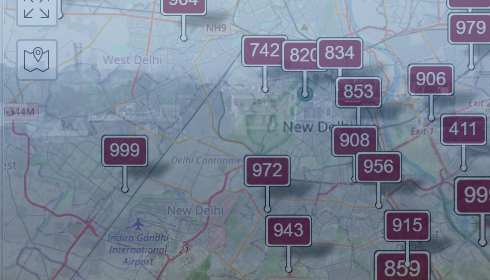
Delhi's Air Quality Crisis continues to be Grim: Data
The air quality in Patparganj, a residential hub in Delhi, has hit a concerning milestone with an Air Quality Index (AQI) of 439 at noon. Categorized as “Severe,” the primary pollutant, PM2.5, was recorded at levels alarmingly beyond the safe threshold. Additional pollutants, including PM10, NO₂, and CO, also showed elevated concentrations, underscoring the complexity and severity of Delhi's air pollution crisis.
The air quality data from Patparganj reveals a dire environmental scenario, with PM2.5 levels averaging between 365 and 494 µg/m³ over 24 hours. The peak concentrations, occurring during early morning hours, point to a deadly combination of vehicular emissions and stagnant atmospheric conditions that trap pollutants. This pattern highlights the intricate interplay of human activity and unfavorable weather, aggravating air pollution levels.
Industries and stone crushers, along with persistent agricultural residue burning, stand out as major contributors to the high levels of PM2.5 and PM10. Meanwhile, the transport sector emerges as a dominant polluter, accounting for 66% of NOx and a staggering 97% of CO emissions. Heavy-duty trucks and buses are significant sources of particulate matter and NOx, while cars and two-wheelers disproportionately emit carbon monoxide and volatile organic compounds (VOCs).
These findings underscore the multifaceted nature of pollution in the area, where industrial, agricultural, and vehicular activities collectively push air quality into hazardous territory.
Despite government interventions, pollution levels have remained significantly above permissible limits, with winter months witnessing severe spikes due to stubble burning and temperature inversions.
The battle against air pollution in Delhi is marred by persistent challenges that hinder progress toward cleaner air. Vehicular emissions remain a dominant source of pollution, with aging fleets and inefficient combustion technologies releasing high levels of nitrogen oxides (NOx) and carbon monoxide (CO) into the atmosphere. These issues are compounded by industrial emissions, as many factories continue to operate without adopting cleaner, more sustainable technologies, significantly contributing to particulate matter pollution. Adding to the crisis is the seasonal menace of stubble burning, which remains rampant despite extensive awareness campaigns. The burning of crop residue, particularly during the winter months, exacerbates pollution levels, creating a toxic mix that leaves the city's air unbreathable. Addressing these intertwined issues requires a multi-pronged approach and coordinated efforts across sectors.
To combat Delhi’s relentless air pollution crisis, a multi-pronged approach targeting transportation, industry, construction, and community practices is imperative. Transforming the transport sector stands as a pivotal step, with the adoption of electric vehicles (EVs) at its core. Encouraging the shift to electric two-wheelers, three-wheelers, and buses through subsidies and enhanced charging infrastructure is crucial. Simultaneously, modernizing aging truck fleets with low-emission alternatives and expanding affordable, eco-friendly public transport systems can significantly reduce reliance on private vehicles. Stricter fuel quality standards and robust emission monitoring will further bolster efforts to curb vehicular pollution.
Industries, another major contributor to the pollution burden, need a mandatory transition to cleaner fuels such as gas and the integration of energy-efficient technologies. Real-time emissions monitoring systems must be deployed to ensure compliance with stringent environmental standards. Dust from construction activities and roads also exacerbates air quality issues. Tackling this requires proactive measures such as vacuum cleaning of major roads, fogging systems at construction sites, and stringent penalties for non-compliance with dust control norms.
One of the most challenging aspects of Delhi’s pollution crisis is stubble burning, a seasonal yet significant contributor to winter smog. Promoting bio-decomposers, subsidizing alternative waste management technologies, and implementing waste-to-energy initiatives can offer sustainable solutions to reduce crop residue burning.
Equally critical are community-centric interventions. Encouraging the adoption of cleaner cooking methods, such as LPG or induction stoves, can address household emissions. Public awareness campaigns must emphasize the dangers of waste burning and advocate for eco-friendly practices, fostering a collective responsibility for cleaner air.
Implementing these measures cohesively and urgently is essential for alleviating the city’s severe air quality woes. By addressing the core contributors with actionable interventions, Delhi can chart a path toward breathable air and a healthier future for its citizens.
Delhi’s air pollution crisis, epitomized by the dire conditions in Patparganj, demands urgent and sustained action. A holistic, multi-sectoral approach addressing transportation, industrial emissions, and agricultural practices is the need of the hour. Immediate, enforceable interventions complemented by long-term regional strategies can help secure a cleaner, healthier future for the residents of Delhi.